




By Irwin Rapoport
CORRESPONDENT
At the eastern end of the ongoing San Benito Route 156 Project that will be completed in fall 2025, Graniterock completed the building of the SR 156/25 Turbo Roundabout Project.
Crews began work on this project in San Benito County in June 2022.
“This was a critical safety project that immediately reduced the number and severity of collisions, while maintaining traffic flow and efficiency at the intersection,” said Jim Shivers, a Caltrans District 5 public information officer. “A turbo roundabout is an innovative, new facility design that operates similar to a regular roundabout, but has additional features that reduce the potential for collisions.”
Some of those additional features include:
• A second circulatory lane is inserted opposite of at least one entry lane;
• Each segment of the roundabout includes one circulatory lane from which drivers can choose whether to exit or continue around the roundabout;
• The diameter of the roundabout is kept small to encourage lower speeds through the roundabout.
• Approach legs and entry are typically at right angles to the roundabout.
Traffic was a construction challenge in more ways than one.
“One was constructing and completing our work while also maintaining traffic on 25 and 156,” said Graniterock Project Manager Mark Hurley Jr. “We weren’t allowed to close any lanes during the day. We had to let all traffic through and provide at least one thru lane in each direction.”
The work was divided into five stages.
“Constructing a project with that many stages is somewhat difficult, making sure that we took up from where we left off on the previous days and we’re not missing any sections of our work,” said Hurley.

General contractor Graniterock has completed the state’s first “turbo” roundabout to improve safety and reduce collisions as part of California’s San Benito Route 156 Project.
Impediments also prevented the work from starting as originally scheduled.
“We had to go through a couple of winter suspensions in 2021 and when we got some clear weather in the spring of 2022,” said Hurley, “we started and then realized the temporary signal plan that was provided really wasn’t a way to construct that and not close or keep traffic flowing. We had to work with Caltrans and our electrical subcontractor to revise the temporary signal plans and ended up putting forward a value engineering proposal. This took the entire summer and by the time we figured all that out, we didn’t get started until the beginning of winter that year and then we

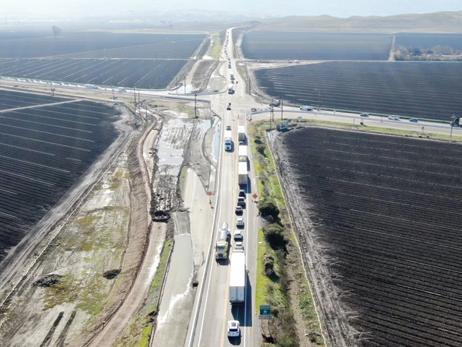

This intersection serves commuters and important goods movement for the region and has been experiencing a pattern of broadside and rear end collisions — more than twice the number of collisions as similar intersections in California.

















































































































History was made with Taylor Machine Works Inc., a manufacturer of material handling equipment, providing the first five commercially available battery electric zero emissions top handlers to Yusen Terminals, a leading provider of marine terminal services at the Port of Los Angeles.
These five commercially available top handlers are the first to go into operation in the nation and will dramatically reduce Yusen’s carbon footprint, and pioneer a greener future for port operations nationwide, according to the manufacturer.
Built by skilled union members in the USA, these innova-
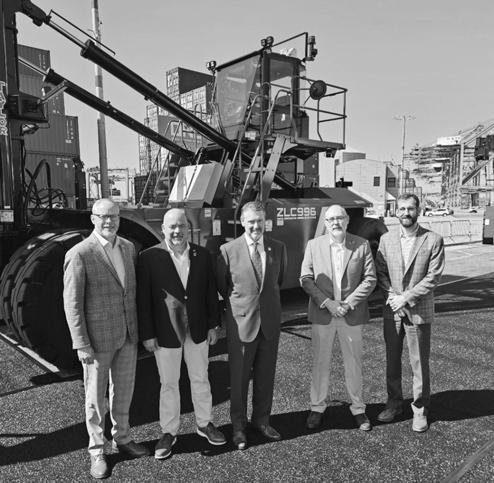
(L-R) are Matt Hillyer, vice president of manufacturing and engineering, Taylor Machine Works Inc.; Hal Nowell, director of sales, Taylor Machine Works Inc.; Robert Taylor, president and COO, Taylor Machine Works Inc.; Spencer Pope, product manager of grant acquisitions/ engineering & sales coordinator, Taylor Machine Works Inc.; and Marshall Boydstun engineering group leader, electric vehicles, Taylor Machine Works Inc.

President and COO
Robert Taylor of Taylor Machine Works speaking at the press conference at Yusen Terminals, where the first five commercially available battery electric zero emission top handlers go into operation at the Port of Los Angeles.

(L-R) are David Turner, vice president of Yusen Terminals; Robert Taylor, president and COO of Taylor Machine Works; and Alan McCorkle, president and CEO of Yusen Terminals, pictured with the ZLC 996 electric loaded container top handler lift trucks.
tive machines mark a significant milestone in Yusen Terminals’ ongoing commitment to sustainability. These machines will be operated by members of the ILWU Local 13 at the marine terminal in the Port of Los Angeles. Later this year, Yusen Terminals will receive three more Taylor electric top handlers, transitioning 25 percent of Yusen’s top handler fleet to zero-emission.
The press conference held at the Yusen Terminals’ San Pedro, Calif., facility, brought together city and port officials, local agencies, union and community leaders, representatives of the Consulate General of Japan and individuals from the freight industry to commemorate this monumental achievement.
Notable speakers at the event included City Councilmember Tim McOsker; Gene Seroka, executive director from the Port of Los Angeles; and President and CEO from Taylor Machine Works Inc., Robert Taylor.
“As an American manufacturer in Mississippi, we are honored that Yusen Terminals allowed us to be their supplier of this equipment for their Zero Emissions Journey,” Taylor said.
“These all-electric cargo top handlers are the culmination of years of rigorous, real-world prototype testing and develop-
ment here at our port,” said Seroka. “I commend Yusen Terminals for its vision and leadership. Our collective commitment to pursuing this technology has paid off, helping prove this equipment’s commercial viability.”
“We are thrilled to unveil the world’s first electric top handlers, representing a significant leap forward in our commitment to sustainability,” said Alan McCorkle, president and CEO of Yusen Terminals. “At YTI, we believe in leading by example and setting new standards for environmental responsibility in our industry. With the introduction of these electric top handlers, we are not only reducing our carbon footprint and continuing to support our local workforce; but also pioneering a greener future for global port operations.”
The five new electric Taylor ZLC 996 Electric Loaded Container Top Handler Lift Trucks boast a remarkable 90,000 lb. capacity, ensuring efficient handling of heavy containers within the port. Designed to operate for up to 18 hours on a single charge, these top handlers offer extended operational time, maximizing productivity while minimizing environmental impact, the manufacturer said.
For more information, visit www.taylorforklifts.com. (All photos courtesy of Taylor Machine Works.)
Balfour Beatty has achieved major milestones on two San Diego County projects including the groundbreaking of the East County Crisis Stabilization Unit in El Cajon, California, and the completion of the Youth Transition Campus Phase 2 project in Kearny Mesa, California.
Balfour Beatty and County of San Diego recently broke ground on the $29 million East County Crisis Stabilization Unit (CSU). The CSU is designed to provide individuals a safe space to stabilize and recover amid a behavioral health crisis in the area as well as help reduce emergency department patient loads, particularly at the nearby Sharp Grossmont Hospital, which has one of the busiest emergency rooms in the country.
The 14,000-sq.-ft. facility will be the first CSU in East County and will feature
expanded services, 24-hour care and recliner chairs for patients to receive assessments, medication assistance, and peer and individual therapy and support. The County’s newest CSU is projected to be completed in fall 2025.
Balfour Beatty also celebrates the completion of the $84.5 million Youth Transition Campus Phase 2 project. This facility replaces the former 70-year-old Juvenile Hall facilities with a state-of-the-art campus that is a nationwide model for therapeutic, trauma-informed and “home-like” youth rehabilitation to improve outcomes for highrisk youth in San Diego County. The new facility features sports and recreational areas, visiting areas and various classroom settings including technical education programs. The Youth Transition Campus Phase 2 accommodates up to 72
youth in 12-bed cohorts that have individual sleeping quarters with private bathrooms, one-on-one counseling spaces, meeting rooms, a shared kitchenette and furnished common dayroom that includes televisions, books and phones. Phase 2 also provides a large garden area with fruit trees and other seasonal plants that will provide fruits and vegetables for the facility’s developing “farm-to-table” culinary arts program.
The facility’s second phase follows Balfour Beatty’s successful completion of the award-winning Youth Transition Campus Phase 1 in January 2022 which received the Design-Build Institute of America Project/Team National Merit Award. The completion of Phase 1 and Phase 2 concludes the five-year, $193.5 million project which was contracted in 2019.
"These milestones demonstrate our commitment to being the County of San Diego's trusted building advisor,” said Dan Ferguson, Balfour Beatty Justice and Civic director in California. “Our long-standing relationship with the County allows us to understand their vision deeply and translate it into facilities that serve the community's evolving needs. We're honored to play a role in improving mental health access and youth rehabilitation services in the county and we look forward to continuing our work to build a stronger, healthier San Diego."
About Balfour Beatty
Headquartered in Dallas, Texas, the company performs heavy civil, rail and a broad variety of vertical construction. To learn more, visit www.balfourbeattyus.com.
Power Inn
4191 Power Inn Road, Suite D Sacramento, CA 95826
916-737-7777
PIRTEK
San Leandro
1997 Burroughs Ave San Leandro, CA 94577
510-568-5000
PIRTEK SFO
121 S. Maple Ave #4 South San Francisco, CA 94080
650-532-9200



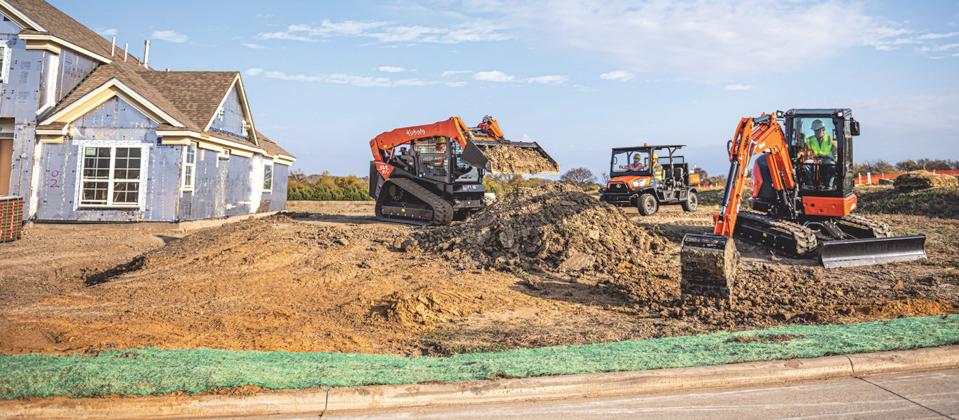






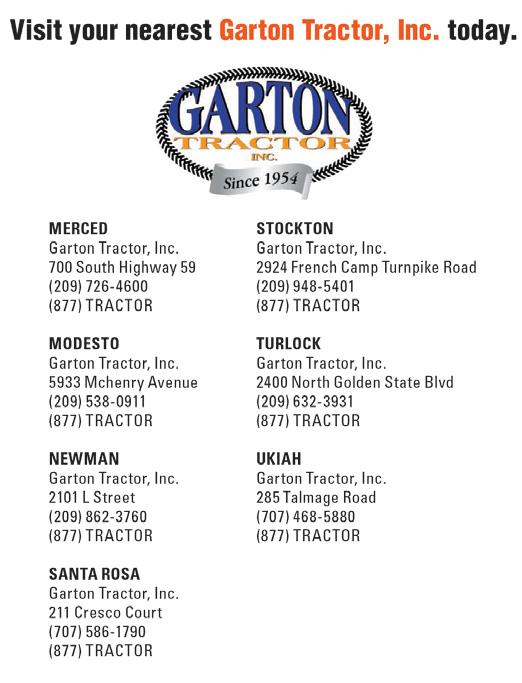
The U.S. General Services Administration (GSA) announced its selection of Hensel Phelps Construction Company to provide design-build services for the final phase of a major modernization and expansion project at the Calexico West Land Port of Entry in California, one of the busiest ports of entry between the United States and Mexico. GSA awarded the contract for $173.6 million to the Phoenix, Ariz.-based firm to complete the port project.
This critical infrastructure development project, funded by the Bipartisan Infrastructure Law and Inflation Reduction Act, will increase capacity and strengthen security and efficiency at the land port of entry.
“The Calexico West Land Port of Entry is another example of how the Biden Administration is making once-in-ageneration investments that bolster safety and security, while strengthening our economy,” said GSA Administrator Robin Carnahan. “These investments are a triple win — creating good jobs that boost our economy and national security, saving taxpayer dollars through reduced energy costs, and building a stronger and more prosperous future for our communities.”
This project will achieve a reduction of 542 metric tons of CO2 emissions from material selections alone. The scope of the project includes the construction of a new 33,000 sq. ft. pedestrian processing facility. In addition to $122 million from the Bipartisan Infrastructure Law investment, the project will utilize approximately $42 million for low-embodied carbon construction materials and $1.7 million for emerging and sustainable technologies including duct sealing to reduce heating and cooling loads and new highly efficient heat pumps. The announcement furthers the Biden-Harris Administration’s Buy Clean Initiative, under which the federal government is, for the first time, prioritizing the pur-

Calexico West Land Port of Entry,” said Congressman Raul Ruiz [CA-25]. “This expansion will reduce border wait times, improve air quality, stimulate economic growth and alleviate outdoor wait times in extreme heat.”
“This project not only supports the needs of today, but also lays the groundwork for future advancements in border management and environmental stewardship,” said Sukhee Kang, regional administrator of GSA’s Pacific Rim region.
“By incorporating advanced technologies and sustainable materials, we are ensuring that the Calexico West Land Port of Entry meets the highest standards of safety, comfort and environmental responsibility.”
The Bipartisan Infrastructure Law includes a total of $3.4 billion for GSA to build and modernize land ports of entry on the country’s northern and southern borders. The investments will improve commerce and trade, enhance security, create good-paying jobs and incorporate innovative sustainability features.
chase of asphalt, concrete, glass and steel that have lower levels of greenhouse gas emissions associated with their production, use, and disposal.
“The individuals and families I serve from Imperial Valley will see great relief with the expansion project at the
The Inflation Reduction Act includes a separate $3.4 billion for GSA to use its buying power to promote the development and manufacturing of low-embodied carbon construction materials and to make federal facilities more sustainable and cost-efficient. GSA’s Inflation Reduction Act projects will implement new technologies and accelerate GSA’s efforts toward achieving a net-zero emissions federal building portfolio by 2045. Through these investments, GSA estimates that it could reduce carbon emissions by more than 2 million metric tons in operational greenhouse gas emissions. That’s the equivalent of taking approximately 500,000 gasoline-powered passenger vehicles off the road for one year.
Construction is anticipated to begin in summer 2025, with completion scheduled for winter 2028.
Caltrans is awarding more than $51 million in planning grants to 89 projects to help make the state’s transportation system more resilient to the impacts of climate change. Of the total, $48.3 million (94 percent) will benefit disadvantaged communities.
With a majority of funding coming from Gov. Gavin Newsom’s clean transportation infrastructure package and the California Climate Commitment, Caltrans awarded planning grants for sustainable, climateresilient transportation projects throughout California to help communities better withstand the impacts of extreme weather events fueled by climate change.
The selected projects will help reduce planet-warming pollution, improve resiliency of the state highway system, enhance access to safe walkways and bike paths and expand natural disaster preparedness. Nearly $29 million comes from one-time state and federal sources made possible by Newsom’s historic $15 billion clean transportation package in the 2022-23 state budget to further the state’s ambitious climate goals. Another $12.4 million comes from Senate
Bill (SB) 1, the Road Repair and Accountability Act of 2017. The awards will fund project planning and conceptual design efforts, helping move the projects closer to construction.
“California is at the forefront of planning transportation projects built to help underserved communities withstand the effects of climate change,” said Tony Tavares, Caltrans director. “By working closely with local partners, we can maintain a sustainable, adaptable and resilient transportation system that will serve all Californians far into the future.”
In total, Caltrans will fund:
• $28.8 million in climate adaptation planning grants — all from Newsom’s clean transportation infrastructure package — to 30 local, regional and transit agencies to identify transportation-related climate vulnerabilities through the development of climate adaptation plans, as well as projectlevel adaptation planning to address climate impacts to transportation infrastructure. Ninety-seven percent of these projects will benefit disadvantaged communities;
• $19.2 million in sustainable communities competitive and technical grants to 50 local, regional and transit agencies for transportation and land use planning, as well as planning for electric vehicle charging infrastructure. This includes more than $6 million to fund planning for 16 projects that improve safety and access for people who walk and bike. Ninety-two percent of these projects will benefit disadvantaged communities;
• $3.4 million in federally funded strategic partnerships grants to nine projects that will plan for managed lanes, training and certification for local elected officials, comprehensive multimodal corridors, transit network and comprehensive operational analyses, improve interregional ADA paratransit coordination, develop airport passenger transportation recommendations, develop a zeroemissions bus fleet, coordinate multimodal transportation and land use compatibility; Caltrans awards transportation planning grants each year through a competitive process to encourage local and regional projects. Applications are evaluated on how projects advance state transportation and cli-
mate goals by identifying and addressing statewide, interregional or regional transportation deficiencies on the highway system. The grant program began in the 201516 fiscal year. Since then, Caltrans has awarded 685 planning grants totaling $266 million and more than 60 percent of those projects have been completed.
SB 1 provides $5 billion in transportation funding annually that is shared between state and local agencies. Road projects progress through construction phases more quickly based on the availability of SB 1 funds, including projects that are partially funded by SB 1.
For more information on projects that are building California’s climate-friendly future, visit build.ca.gov and RebuildingCA.ca.gov.
To view the complete list of this year’s planning grant project awardees, visit https://dot.ca.gov/programs/transportationplanning/division-of-transportation-planning/regional-and-community-planning/sustainable-transportation-planninggrants/2024-2025-sustainable-transportation-planning-grant-winners


This intersection serves commuters and important goods movement for the region and has been experiencing a pattern of broadside and rear end collisions — more than twice the number of collisions as similar intersections in California.
TURBO from page 1
had some weather and the winter suspension.”
This portion of work began in spring 2023 and it was continuous and on schedule. The project was delivered in February 2024 and final acceptance/completion was confirmed in April.
The majority of the work was done during day with crews protected from live traffic by K-rail.
“Towards the end of the project,” said Hurley, “a lot of our paving was done at night. While there was plenty of room, it was tight for all five stages in the sense that our work butted up right against the traffic. There was only so much extra room.”
As the project was beset with several challenges, cooperation between Graniterock and Caltrans was a necessity.
“Relations with Caltrans were pretty good,” said Hurley. “I’ve worked with Baljinder Brar, the resident engineer on the project, on three previous projects and Luis Jimenez, the Caltrans inspector, was easy to work with. We all wanted to do a good job. The three of us live in Hollister — we shared that common living area and just worked together to build this project.
“The critical path for each stage had us moving the existing area — asphalt and base rock out and building a new section,”said Hurley. “That required grinding off eight to 12 inches of asphalt and removing four inches of base rock beneath, The majority of that material was reused on-site. We had a PEP screen about 1,000 feet away from the job site. We hauled the material there, screened it, and brought it back to re-use as our subbase. The excavation operations went fairly well. It was a little slower than we anticipated, but that’s standard ‘not everything goes according to plan.’”
For each phase, crews excavated an area, prepped the site and paved the sections of the roundabout.
Paving operations took place at night. Graniterock supplied the asphalt.
The center circular section consists of coble and concrete.
The new lanes are 13 to 21 ft. wide, with the majority being 14 ft. wide.
“It was difficult to piece mill the paving,” said Hurley “With the turns and different sections, it was like paving a parking lot.”
Equipment operators used a variety of pieces of iron, including a 210 skip, 10-ft. track paver, 79-in. DD roller, 67in. DD roller, 772 GP motor grader and an 84-in. padfoot compactor.
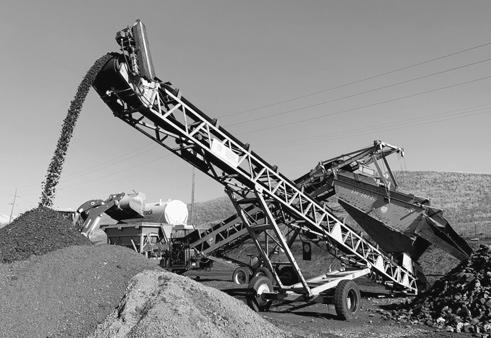
The three-lane roundabout with three exits replaced a standard two-lane in each direction intersection with traffic lights.
Hurley was assisted by an excellent team, with Foreman Brandon Cole overseeing most of the work and Foreman Ray Espino handling operations toward the end. Nick De La Torre and Marco Lopez served as the paving foremen. Also on the team were Project Engineer Todd Benson and Jeannie O’Donnell, a contract administrator who handled the paperwork.
“We worked well together,” said Hurley. “That is just standard here at Graniterock — it’s just the framework and the employees. The crews gave a 100-percent effort. They did everything that was asked of them and then some. It was a tough project, but those guys worked through the heat of summers and some of the rain of winter. Those guys went above and beyond.”
Busy days required 15 people on the paving crew, five electricians and five traffic flaggers. The subcontractors were ABSL, APCO Dike, Austin Enterprises, Bear Electric, Central Striping Service, Coral Construction Company, Farwest Safety, KCI Environmental and KRC Safety.
Excavation operations generated 23,242 yds. of asphalt and subbase, New materials included Class 1 subbase and class 2 base and Asphalt.
Graniterock has a sizable fleet and takes good care of it.
“We really didn’t run into any wear and tear issues on this project,” said Hurley. “There weren’t any issues with the work and equipment. We did have an on-site mechanic for the paving operations. It’s a requirement for the field guys to inspect the equipment. Our fuel trucks make the rounds and they are on-call.”
The company purchases and rents equipment from Quinn Company (Cat equipment) and Cresco Equipment Rentals
“Anytime we needed a piece of equipment, whether it was Graniterock owned or rented, our equipment department handles that for us,” said Hurley. “Equipment was delivered on time and we never had any issues with our pieces or those from our vendors. The equipment department has a good relationship with the vendors.”
“This intersection serves commuters and important goods movement for the region and has been experiencing a pattern of broadside and rear end collisions — more than twice the number of collisions as similar intersections in California,” he added. “Improving Highway 25 and constructing a new interchange at Highways 25 and 156 is part of Caltrans’ and the Council of San Benito County
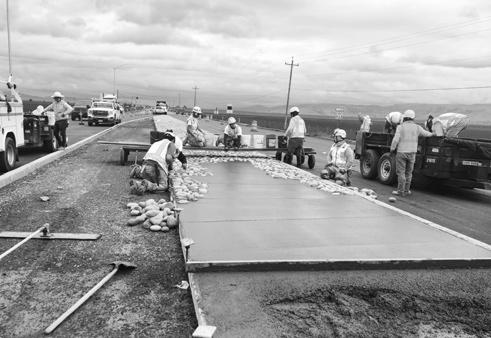
The new lanes are 13 to 21 ft. wide, with the majority being 14 ft. wide.
Governments’ [SBtCOG] vision for the region.”
Planning for the project began in April 2017
Motorists are pleased with the new roundabout, said Brar.
“Per my office’s outreach to local residents, friends and family,” he said.
The three-lane roundabout with three exits replaced a standard two-lane in each direction intersection with traffic lights.
The project is fully funded through State Highway Operation & Protection Program funds (SHOPP). Construction and right-of-way costs were $11.1 million and support costs were $3.8 million.
The roundabout was designed by Caltrans, which completed its work in May 2021.
“The traffic situation has vastly improved after the opening of the turbo roundabout,” said Brar. “The capacity increase has been demonstrated by the absence of commute time queues and the relative emptiness compared with the earlier signalized intersection at most times. The vehicles arrive and get flushed out of the intersection quickly. Assuming no more T-bone accidents caused by the lastminute vehicles trying to clear the intersection before it gets red has improved the safety as well. The future CHP accident data will hopefully prove it.
“The project has improved safety by increasing the highway lighting by a factor of five,” he pointed out, “added lane separation curbs and median dividers, OH signs upstream to help choose lanes well in advance, dedicated right turn lanes, solved the issue of signal power outage under PG&E’s PSPS program. No maintenance is needed due to power outage/faulty signal equipment/loop detector damage.”
The traffic management plan was based on temporary lane closures. Construction started after the utility work was completed.
“Traffic was an issue before the project started, and somewhat of an issue during construction as far as getting materials to the job site,” said Hurley, “that wasn’t too big of an issue. It was just dealing with standard day-to-day commute traffic, — people coming in and out of Hollister. Some of the work was performed at night to avoid some of the traffic. Hauling asphalt at night was more ideal for us, so we didn’t have trucks sitting in traffic, and now that the project has been completed, traffic is flowing much better to what it used to be with the signals.” CEG
(All photos courtesy of Graniterock.)


The State of California recently honored Caltrans employees by presenting them with the Governor’s State Employee Medal of Valor, the highest honor California bestows on its public servants. The awards are given annually to state employees for acts of heroism to save lives or protect state property.
“We are extremely proud of these nine Caltrans workers who courageously saved others while putting their own lives at risk,” said Caltrans Director Tony Tavares. “Today, our entire Caltrans family joins Governor Newsom in honoring them and thanking them for their selfless acts.”
Gold Medal of Valor
• Geoff Clute, District 4 bridge maintenance supervisor, for saving a man trapped inside a burning vehicle in Solano County on July 7, 2023.
Silver Medal of Valor
• Sultan Abassy, District 12 transportation engineering technician, for heroism during a dangerous rescue to save an unconscious motorcyclist after his bike skidded sideways in Orange County on July 20, 2023;
• Danny Dube, District 2 electrician, for saving a woman from her damaged vehicle that had rolled over into the center highway divide on a foggy day in Siskiyou County on Feb. 7, 2023;
• Kenny Myers, Bruce Perry and Darrell Van Natta, District 3 equipment operators, for rescuing a driver and five passengers who were trapped in their burning vehicle in the Sierra Nevada on Dec. 28, 2022;
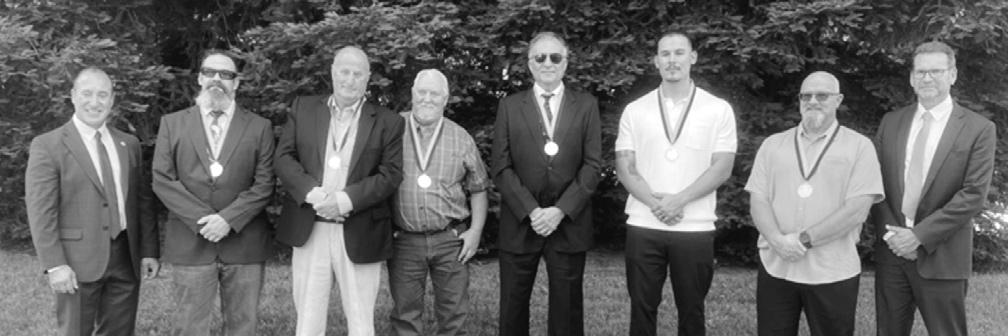
Geoff Clute and Deputy Director Michael Keever. Awardees not
and Gonzalo Garcia.
• Michael Butner and Gonzalo Garcia, District 1 tree maintenance workers, for rescuing a couple after their RV became trapped in heavy snow and low hanging trees in Mendocino County on Feb. 23, 2023. The trees crashed through the RV and split it in half;
• Davidray Sumaya, District 7 electrician, for rescuing two travelers that became trapped in their vehicle by flood waters on Interstate 5 during winter storms in Los Angeles County on Feb. 23, 2023. have earned the honor for their courage and selflessness in the face of danger.
The State Employee Medal of Valor award was first pre-



sented by Governor Edmund G. Brown Sr. in 1959. Gold medals are awarded to state employees who perform extraordinary acts of heroism at great risk to their own life to save another human being. Silver medals are presented to those whose act of heroism extended above and beyond the normal call of duty at personal risk to their safety to save human life or state property.
In the 65 years of these awards, more than 800 state employees, including 125 from Caltrans, have earned medals of valor for their courage and selflessness in the face of danger.
Build California, a program of the 501(c)3 non-profit AGC Construction Education Foundation, has launched a virtual educational event aimed at helping those interested in kickstarting a career in the construction industry. The “Build A Legacy” info sessions are a key component of Build California’s outreach and community-building efforts for the DIR DAS ERiCA Grant. During these sessions, students and community members learn about a variety of career possibilities in the industry, along with the minimum qualifications to get started. Each session includes resources for training and education, and all who attend are eligible to receive personalized career counseling from Daniel Torres, Career Counseling & Placement Manager, who has nearly two decades of experience in the construction trades and workforce development programs. As a result, six individuals have been placed in construction careers or pre-apprenticeship programs during a two-month period in spring 2024.
With the support of DIR DAS ERiCA
Grant, Build California has seen a significant increase in its success to reach and activate the next generation of construction workers. Build California revamped its social media advertising recruitment campaign and has generated over 4,400 new sign-ups on its website this year. In 2023, the total signups of those seeking a career pathway on the Build California website was just over 700. More than 75% of info session attendees have come from website sign-ups, while the remaining 25% come from outreach at career fairs and other community events.
Sponsorships for the “Build a Legacy” info sessions offer AGC member companies’ unique opportunities to boost their community engagement and workforce development efforts. By supporting and investing in these sessions, your company can help develop a skilled, effective, and motivated construction workforce. To leverage this community engagement opportunity, please contact Daniel Torres at Torresd@agc-ca.org.

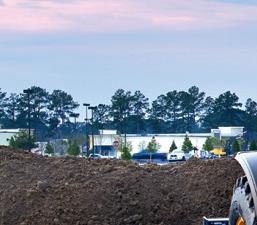










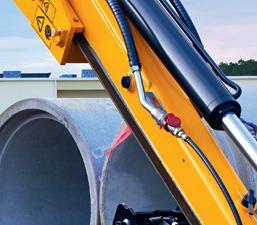




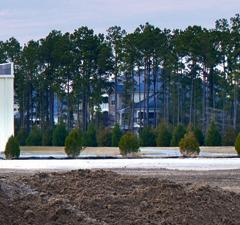











1960 Highway 20 Colusa, CA 95932 (530) 458-2166













2173 Blossom Street Dos Palos, CA 93620-2313 (209) 392-2161 600 S. State Highway 59 Merced, CA 95341-6928 (209) 383-5888
1340 W. Charter Way Stockton, CA 95206 (209) 944-5500
1215 West Glenwood Ave Turlock, CA 95380-5703 (209) 634-1777 827 North Tehama St Willows, CA 95988 (530) 934-3382
3056 Colusa Highway Yuba City, CA 95993 (530) 923-7675
